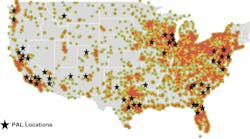In early May, FMCSA proposed four revisions to the way its SafeStat system ranks the safety performance of interstate motor carriers.
My guess is that the changes are being suggested in response to the findings of the February 2004 DOT and the October 2004 Oak Ridge National Laboratory reports. Both studies revealed significant inaccuracies in carrier rankings, primarily because of weaknesses in the way states file information with the federal truck safety database. (See “Safety Matters,” 2/05 & 3/05.)
According to FMCSA's web site (www.ai.volpe.dot.gov), the proposed revisions include:
-
New Traffic Violations Indicator (TVI). This would replace the Moving Violations Indicator (MVI) currently used in the Driver SEA calculation.
-
Shortened Data Exposure Time Period. Reduce the data time window to 24 months from 30 months.
-
Simplify Accident SEA Value. Establish one standard of measuring crash rate.
-
Include Additional Vehicle Out of Service Data.
The new TVI is a step in the right direction because it will significantly increase the impact of poor on-road performance, giving it equal billing with driver inspection and compliance data.
It will also fix a flaw in the current system, whereby a moving violation is counted in the SafeStat database only if the reporting state assigns it one of 12 SafeStat sub-categories. Some states clump moving violations together under a “general” category, which means SafeStat doesn't take them into account. Others fail to record the information or fail to send it to the federal database.
When FMCSA applied the proposed changes to the data used in the ORNL report, the number of Category A & B carriers increased by 30%, and their group crash rate rose 12% compared to the current formula.
I'm sure a number of industry executives and safety zealots will respond to this proposal with comments like “not far enough” and “not fast enough.”
I, too, could be tempted to react that way. In the columns mentioned above, I talked about how SafeStat, as currently configured, could be attacked by both sides because of late and/or missing crash data.
I also proposed a model that would not rely so heavily on crash data to identify high-risk carriers. Instead, it would place more emphasis on roadside performance by incorporating driver violation and conviction information.
While my resolve for such an approach is unwavering, I also realize that such an extensive overhaul will require a significant investment of time and resources, as well as extensive cooperation and vetting.
However, we should not eliminate the current SafeStat model until we have the next version fully developed. That would be akin to saying we should stop driving until our current energy crisis is resolved.
FMCSA's proposed changes have my support, with one caveat. Using the findings from the recent “ATRI High Risk Driver Study” and the FMCSA “Large Truck Crash Causation Study” — both of which emphasize the importance of identifying and managing at-risk driver behavior in reducing the number of truck crashes — let's develop a comprehensive truck safety model that accurately predicts which carriers have the greatest likelihood of being involved in future crashes.
Ignoring this opportunity to take the bigger step would be like pretending that the introduction of hybrids could single-handedly solve the energy crisis.
Jim York is the manager of Zurich Service Corp.'s Risk Engineering Transportation Team, based in Schaumburg, IL.


